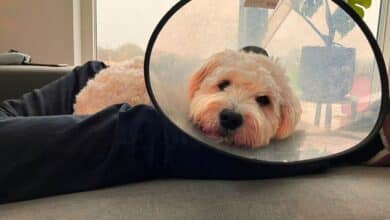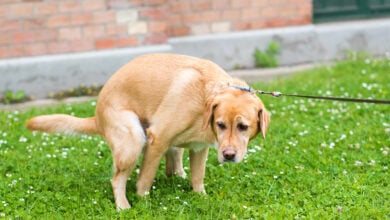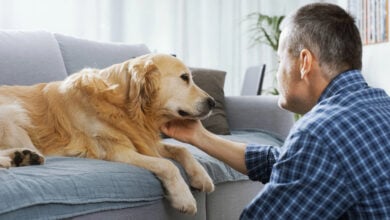Can Dogs Get Hemorrhoids? The Ruff Reality Of Swollen Behinds
When you purchase through links on our site, we may earn a commission. Here’s how it works.

Has your dog been scooting around on your floors like they’re trying to moonwalk? Maybe they’re straining during bathroom breaks, or their rear end looks red and irritated. Naturally, your first thought might be, “Oh no, does my dog have hemorrhoids?” After all, we tend to assume our pets suffer from the same awkward ailments we do.
Table of Contents
But here’s the twist: Dogs don’t get hemorrhoids. That’s one embarrassing human problem they’ve managed to dodge. Unfortunately, that doesn’t mean their butts are in the clear. Plenty of other reasons your pup’s backside might be causing them trouble. Let’s dive into what’s really going on and, most importantly, how you can help.
Do Dogs Get Hemorrhoids?
Ah, hemorrhoids. These swollen blood vessels in the lower rectum or anus are basically your veins throwing a tantrum after too much straining on the toilet. Humans get hemorrhoids in two equally unpleasant varieties: internal (hidden away inside like a terrible surprise) and external (announcing their presence with inflammation, swelling, and the kind of discomfort that makes sitting feel like a cruel joke).
So, what causes these unwelcome guests? Excess pressure. Whether it’s chronic constipation, diarrhea, or an unfortunate overconfidence in your ability to “just push through it,” too much strain on the veins leads to this literal pain in the butt. Some unlucky souls even develop them from pregnancy, heavy lifting, or long hours of sitting—so yes, your desk job might be conspiring against you.
Why Dogs Don’t Get Hemorrhoids (Lucky Them)
Now, here’s where our four-legged friends get to flex on us. Dogs don’t get hemorrhoids. Ever. Not because they eat better or live stress-free lives (unless you count the utter horror of the vacuum cleaner), but because their gastrointestinal anatomy is built differently.
Since humans walk upright, our digestive tracts run vertically. On the other hand, dogs walk on four legs, keeping their GI system running horizontally. This simple structural difference means less pressure on their rectal blood vessels, sparing them from the curse of hemorrhoids.
But That Doesn’t Mean Their Butts Are In The Clear
Just because dogs don’t get hemorrhoids doesn’t mean they’re off the hook regarding rear-end problems. Many dog owners mistake specific butt-related issues for hemorrhoids when something entirely different (but equally unpleasant) is going on. The most common offender? Blocked anal glands—those lovely little scent-marking organs that can become painfully full and inflamed.
And that’s just the beginning. Dogs can also suffer from anal tumors, rectal prolapse, perianal fistulas, and other uncomfortable conditions that can make them scoot, strain, or look generally miserable. The good news? These problems usually have clear solutions.
Signs In Dogs Often Mistaken For Hemorrhoid Symptoms
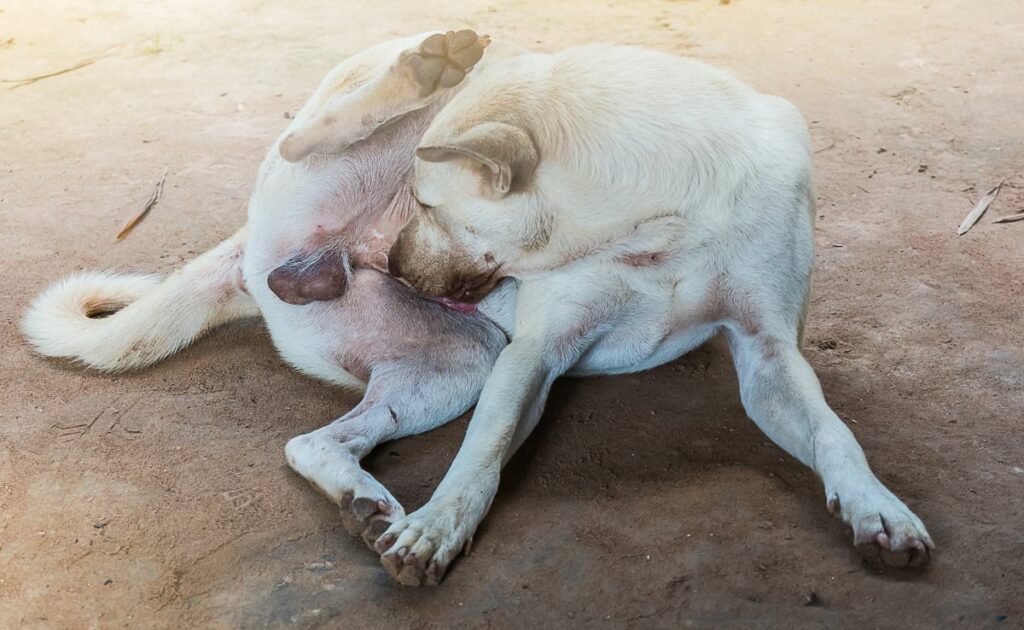
- Anal discharge
- Anal redness and inflammation
- Bloody stools
- Difficulty or straining when defecating
- Excessive licking or biting at their rear end
- Pain when sitting down
- Scooting their rear along the floor
Scooting and anal itchiness can also be signs of intestinal parasites. Puppies are particularly prone to worms, so it’s important to ensure you’re following your veterinarian’s puppy deworming schedule to keep your furry friend healthy.
Conditions Confused For Dog Hemorrhoids
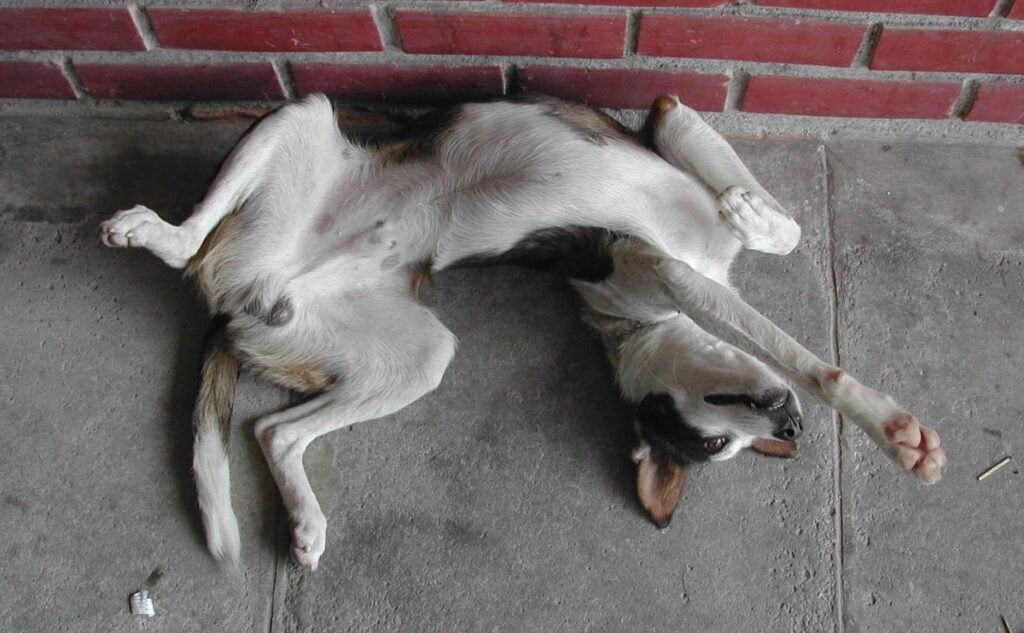
If your dog’s rear end is causing a scene, but hemorrhoids aren’t the culprit, then what’s really going on back there? While dogs may be spared from this particular human misery, they’re not off the hook when it comes to butt-related troubles. Plenty of conditions can make your pup scoot, strain, or look downright uncomfortable, leading many owners to assume hemorrhoids are to blame.
Let’s break down what might be causing your pup’s behind-the-scenes trouble and how you can help.
The Usual Culprit: Anal Gland Problems
If there were a leaderboard for the most common cause of canine butt problems, anal glands would take the top spot every time. These tiny, grape-sized sacs sit on either side of your dog’s anus like little scent-filled landmines. Normally, they empty themselves whenever your dog poops, releasing a distinctively awful-smelling liquid that helps with scent marking. Gross? Absolutely. Necessary? Also yes.
But sometimes, these glands don’t empty properly, leading to impaction, infection, or even full-blown abscesses that can make your dog’s rear end itchy, swollen, and incredibly uncomfortable. Instead of a smooth bathroom break, your pup scoots across the floor like a four-legged Roomba.
Who’s Most At Risk?
Some dogs are more prone to anal gland problems than others. Smaller breeds like Cavalier King Charles Spaniels, Cocker Spaniels, Miniature Poodles, and Lhasa Apsos tend to have a higher risk of impaction simply due to anatomy. Overweight dogs and those with chronic skin conditions, like allergies, are also frequent victims.
Diagnosis And Treatment
If your dog is scooting excessively, licking their rear end, or leaving behind an unmistakable fishy smell, a trip to the vet is in order. A veterinarian will typically diagnose impacted or infected anal glands with a simple (but deeply unpleasant) manual exam. In other words, they’ll put on a glove, apply some pressure, and determine if the glands are blocked, inflamed, or in worse shape than your dog’s dignity.
Treatment depends on the severity of the issue. Mild impactions can often be resolved with a manual expression—again, not fun for anyone involved. The vet may prescribe antibiotics, anti-inflammatory medication, or even flush the glands to clear them out if infection is present. In chronic problems, a high-fiber diet or supplements can help prevent future issues.
Our Personal Experience With Anal Gland Issues
Both of our Cavalier King Charles Spaniel dogs have had ongoing anal gland issues. One would scoot across the floor when her anal glands were full.
However, the other didn’t show any symptoms until it was too late. We took him to the emergency vet both times where they removed the excess fluid and provided relief to the swollen area. They also prescribed pain medication and antibiotics to prevent further infection and recommended using a wet, warm compress to reduce swelling.
– Sadie Cornelius, Parent to dogs with chronic anal gland issues
Rectal Prolapse: When Things Get Even More Complicated
If you ever glance at your dog’s rear end and see something that absolutely should not be there, you might be looking at a rectal prolapse. This condition occurs when part of the rectum pushes its way out through the anus. A prolapsed rectum looks like a cylinder-shaped mass sticking out of your pup’s backside, which is why so many pet parents mistake it for hemorrhoids.
While it might be tempting to wait and see if it “goes back in on its own,” that’s a gamble you don’t want to take. The longer the rectal tissue is exposed, the higher the risk of damage, infection, and even tissue death (necrosis). In other words, this is not a “wait and see” situation—it’s a “call the vet immediately” kind of problem.
Who’s Most At Risk?
Rectal prolapse is most commonly seen in younger dogs, especially puppies with severe diarrhea or chronic straining during bowel movements. Since their digestive systems are still developing, persistent irritation or excessive pressure from trying to poop can lead to the rectum deciding to stage a dramatic exit.
It’s also more likely to occur in dogs suffering from gastrointestinal parasites, inflammatory bowel disease (IBD), or chronic constipation. If your pup’s digestive system constantly struggles, their rectum might metaphorically throw in the towel.
Diagnosis And Treatment
A vet visit should be priority number one if your dog has a suspicious mass sticking out of their backside. A veterinarian can diagnose rectal prolapse with a simple physical exam, but they’ll also dig deeper to figure out what caused it in the first place. That might mean stool tests for parasites, bloodwork to check for underlying conditions, or imaging to rule out intestinal blockages.
Treatment depends on the severity. In mild cases where the tissue is still healthy, the vet may manually push the rectum back in place and place a few stitches to prevent it from slipping out again. They’ll also treat the underlying cause, whether diarrhea, constipation, or something more serious.
For more severe cases, surgery may be required to remove unhealthy tissue and secure the rectum in its rightful place. In either case, aftercare will likely involve stool softeners, anti-inflammatory medication, and keeping your pup from licking or messing with the area.
Rectal Or Anal Masses: When Things Take A Turn For The Worst
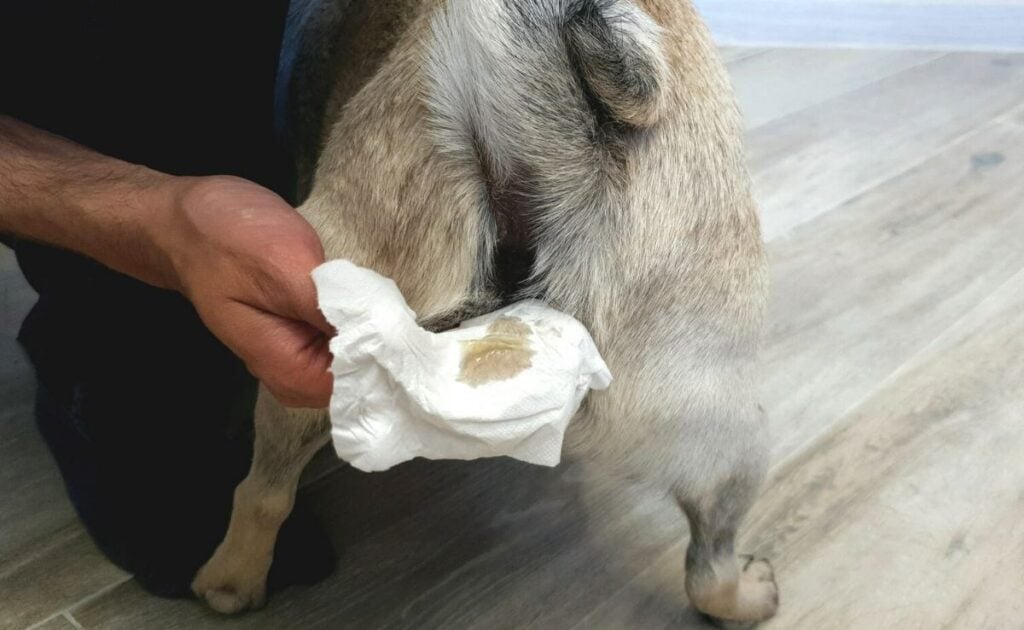
Unlike a rectal prolapse, where the rectum itself makes an unscheduled appearance, rectal and anal tumors are growths that develop in or around the anus or rectum. Some are benign and harmless, while others can be malignant and require immediate treatment.
The most common offenders? Anal gland tumors. These masses can start small and go unnoticed. As they grow, they can cause swelling, discomfort, difficulty defecating, and sometimes even changes in behavior as your dog tries to cope with the pain.
Who’s Most At Risk?
Certain breeds are more prone to anal gland cancer, particularly Cavalier King Charles Spaniels, Cocker Spaniels, German Shepherds, and Springer Spaniels. However, any dog can develop an anal or rectal mass, especially as they age.
In addition to genetics, hormonal imbalances, chronic inflammation, and environmental factors may also contribute to tumor development. Regular vet check-ups can help catch these issues early before they start causing major problems.
Diagnosis And Treatment
If you notice swelling, difficulty pooping, or a suspicious lump near your dog’s anus, it’s time for a vet visit. A veterinarian will start with a physical exam, often followed by imaging tests (X-rays, ultrasound) and a biopsy, to determine whether the mass is benign or cancerous.
Treatment depends on the type and severity of the tumor. Benign growths might only need monitoring, while malignant tumors often require surgical removal, sometimes followed by chemotherapy or radiation therapy.
Even if the tumor is benign, its location can still cause discomfort or interfere with normal bowel movements, so removal may still be recommended. In some cases, anal gland removal is necessary to prevent recurrence.
Perineal Hernia: When Things Start Pushing Through Where They Shouldn’t
If your dog has a strange swelling near their anus that looks like a bad case of hemorrhoids, it might actually be a perineal hernia. This condition occurs when part of an internal organ—usually the bladder, prostate, or intestines—squeezes through weakened muscle tissue near the pelvic area. Instead of staying where it belongs, the displaced organ creates a noticeable bulge, usually just below or to the side of the anus.
While it might not seem like an emergency at first, perineal hernias can lead to serious complications, mainly if they cause difficulty urinating or defecating. In some cases, the bladder can become trapped, leading to a life-threatening situation that requires immediate medical attention.
Who’s Most At Risk?
Perineal hernias tend to target middle-aged to senior, unneutered male dogs. Certain breeds are also more genetically predisposed to perineal hernias. Boston Terriers, Boxers, Collies, Dachshunds, Old English Sheepdogs, Pekingese, and Welsh Corgis are all at a higher risk. If your dog falls into one of these categories and you notice an unusual swelling near their rear end, a vet check-up is necessary.
Diagnosis And Treatment
A veterinarian can usually diagnose a perineal hernia with a physical examination, feeling for the bulging tissue around the pelvis. However, X-rays or ultrasound may be needed to determine which organ is involved and assess the severity of the condition.
In mild cases, dietary changes and stool softeners might help manage symptoms temporarily, but in most cases, surgery is required to repair the hernia and reinforce the weakened muscle tissue. If the bladder or intestines are trapped, emergency surgery may be necessary to prevent life-threatening complications.
Since hormonal influences contribute to this condition, neutering is often recommended at the time of surgery to reduce the risk of recurrence.
Perianal Fistula: When Your Dog’s Butt Becomes A Battlefield
If you’ve noticed open, oozing wounds around your dog’s anus, along with a truly unholy smell, you might be dealing with perianal fistula. This condition is as unpleasant as it sounds. It involves chronic, infected sores in the tissue surrounding the anus, often forming deep, painful tunnels beneath the skin.
Dogs suffering from perianal fistula may lick obsessively, strain while pooping, or act irritable due to constant discomfort. Unfortunately, this isn’t just a surface-level problem. If left untreated, the infection can spread deeper into the rectum, making it even more painful and difficult to manage.
Who’s Most At Risk?
Perianal fistulas usually affect older dogs, and some breeds are far more prone to this miserable condition than others. German Shepherds are the most commonly affected, but Retrievers and Setters can also develop it.
There’s a suspected autoimmune component to perianal fistulas, meaning a dog’s immune system might be overreacting and attacking the tissue around the anus. Chronic inflammation, poor circulation in the area, and even the shape of certain dogs’ tails and rear anatomy may also play a role.
Diagnosis And Treatment
If your dog has foul-smelling, draining sores around their anus, a vet visit is essential. Diagnosis is usually based on a physical exam, but in some cases, imaging or tissue biopsies may be needed to rule out tumors or other conditions.
Since perianal fistulas tend to persist and worsen over time, treatment must be aggressive and consistent. This typically includes:
- A high-fiber, easily digestible diet to reduce straining and irritation
- Antibiotics and pain relief to manage infection and discomfort
- Immunosuppressive medications to calm the overactive immune response
- Surgery or laser therapy in severe cases to remove damaged tissue
Many dogs require lifelong management to keep symptoms under control, but early intervention can make a huge difference.
Covering Treatment Costs

Before facing costly vet bills, consider getting pet insurance while your dog is still young and healthy to cover unexpected illnesses and accidents. By signing up before health issues that can be regarded as preexisting conditions start, you won’t have to choose between your wallet and your pup’s health care needs.
Frequently Asked Questions
Here are some of the most common questions pup owners have about rear-end problems with dogs. Don’t see yours? Ask us in the comments!
Can You Use Human Hemorrhoid Cream On Dogs?
You may be tempted to use Preparation H or another human hemorrhoid cream on your pup to relieve anal itching or discomfort, but it’s not recommended for dogs. These creams may not be safe or effective for dogs.
Do Dogs Get Hemorrhoids That Bleed?
Human hemorrhoids can bleed, but no, dogs don’t get hemorrhoids that bleed since they don’t get hemorrhoids. If you notice blood anal bleeding or the presence of blood in your dog’s feces, you should contact your vet as soon as possible. One of the most common causes is colitis (inflammation of the colon), but rectal polyps and cancer can also cause rectal bleeding.
What Do Dog Hemorrhoids Look Like?
Pup owners can mistake rectal prolapse or a perineal hernia as the sign of hemorrhoids in their dogs. The protrusion outside of their pup’s anus can look similar to external human hemorrhoids.
How Can I Relieve My Dog’s Pain?
Various anal and rectal problems can be quite painful for your pup, and we hate to see our furbabies suffer. To temporarily relieve discomfort, you can safely apply a warm compress to your dog’s anal area. Although you may be tempted to turn to your medicine cabinet, do not give your pup human pain medications. There are some natural ways to give your dog pain relief, but it’s best to check with your veterinarian to make sure anything you’re considering is safe for your pup.
Why Trust Canine Journal?
Sally has over 20 years of experience in human health sciences communications, including more than 10 years as an expert on pet health conditions and treatment. She’s part of a team of dedicated canine professionals and long-time dog owners at Canine Journal. We test and research the best pet products, not only for our own pups but for all of our readers.
